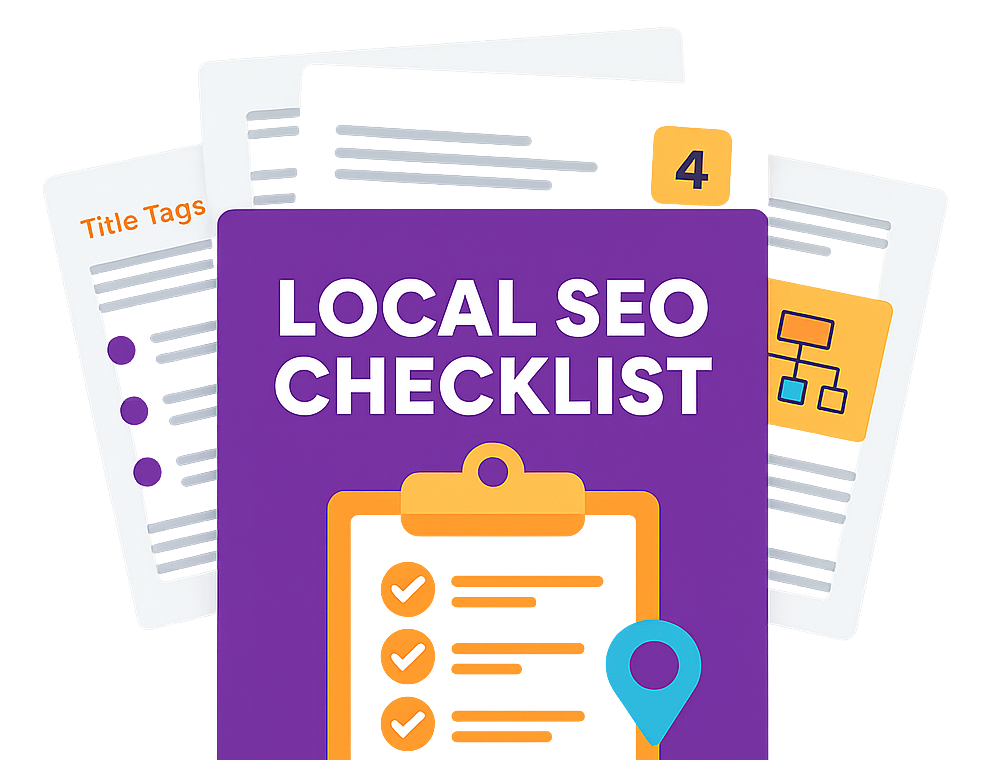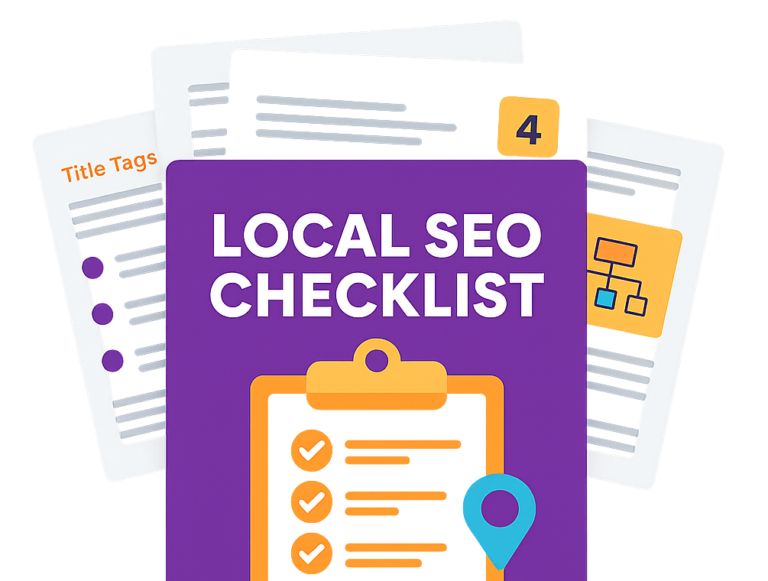Choosing the right keywords isn't about chasing high search volumes. It’s about aligning your website's content with your business goals and what your audience is actually searching for. Get this foundation right, and you’ll attract visitors who are genuinely interested in what you offer, turning casual searchers into real customers.
Build Your Foundation for Keyword Success
Before you even think about firing up an SEO tool, let's get the groundwork sorted. The most crucial part of choosing the right keywords for your website has nothing to do with data. It starts with a clear-eyed look at your own business objectives and the people you’re trying to reach.
What does success actually look like for you?
Effective keyword selection is tied directly to your commercial goals. Are you trying to get the phone to ring for your service business? Drive sales on your e-commerce site? Or are you playing the long game, building your brand's authority in a niche? Each goal demands a completely different keyword approach.
Define Your Primary Business Goals
First things first: what do you want your website to achieve? Without this clarity, your keyword strategy will be all over the place. The goal is to attract traffic that takes a specific, valuable action.
Think about these common objectives:
- Generating Leads: Your focus will be on keywords that scream "I need a solution," like "emergency plumber in Cambridge" or "bespoke joinery quotes."
- Driving E-commerce Sales: Here, you're targeting product-specific keywords with clear buying intent, such as "buy handmade leather journal UK" or "next day delivery on running shoes."
- Building Brand Authority: This is where you target informational keywords to answer questions, like "how to choose the right paint finish" or "what are the benefits of sustainable packaging."
- Increasing Local Footfall: Local businesses need those geographic modifiers. Think "best coffee shop near Ely Cathedral" or "Cambridgeshire farm shop."
By tying every keyword choice to a specific business outcome, you stop just attracting visitors. You start attracting potential customers who are already part of the way through their buying journey.
Understand Your UK Audience Deeply
Once your goals are locked in, you need to get inside the head of your ideal customer. Who are they? What problems are they trying to solve? And, crucially, what language do they use to talk about their needs? A detailed customer persona is a brilliant way to keep this thinking focused.
This isn't just about demographics. It's about their motivations, their pain points, and the questions they're asking. For instance, a homeowner frantically searching for "how to fix a leaking tap" has a very different (and more urgent) need than someone browsing for "luxury bathroom renovation ideas."
To really get this right, go talk to your customer-facing teams. Your sales and customer service staff hear the exact phrases and questions customers use every single day. Their insights are an absolute goldmine for finding authentic, high-intent keywords that SEO tools often miss.
This groundwork is a non-negotiable first step. If you're launching a new site, our SEO checklist for a new website offers a structured path to make sure all these foundational elements are properly in place from day one.
Brainstorming Your Initial Keyword List
Alright, now that you've got your goals dialled in, it's time for the fun part: building your first keyword list. Don't worry about finding the perfect, data-backed terms just yet. Right now, it’s all about exploration—casting a wide net to catch every possible way a customer might look for what you do.
This first draft is often called a 'seed list', and it’s the raw material we’ll refine later with more technical analysis. Think of it as a creative brain dump. No idea is too weird or too niche at this stage.
Think Beyond Your Products and Services
The most obvious place to start is with what you sell. If you're a landscaping company based in Cambridgeshire, you'd naturally jot down "garden design Cambridge," "patio installation," and "lawn care services." That's a solid start, but it’s really just scratching the surface.
To truly figure out how to choose keywords for a website, you need to get inside your customer's head. What problems are they actually trying to solve? Nobody wakes up thinking, "I need patio installation services today." They're far more likely to be searching for things like "how to create a low-maintenance garden" or "ideas for small garden seating area."
Your seed list needs to cover:
- Your core services: The stuff you sell directly (e.g., "bespoke kitchen fitting").
- Problems you solve: The headaches your customers are dealing with (e.g., "outdated kitchen storage solutions").
- Alternative phrasing: How people might describe your service differently (e.g., "kitchen refurbishment" instead of "kitchen renovation").
Tap into Real Customer Language
SEO tools are brilliant, but they don't always pick up on the nuances of real conversation. The absolute best keyword ideas often come straight from the mouths of your customers. This is where you'll find authentic, high-intent phrases your competitors are probably missing.
Your customer service and sales teams are a goldmine. Seriously. They’re on the front lines, hearing about customer frustrations, questions, and goals every single day. Ask them for a list of the most common questions they get—each one is a potential keyword. A simple question like, "Do you offer eco-friendly packaging options?" hands you the keyword "eco-friendly packaging" on a silver platter.
Don't underestimate your internal teams. They interact with your target audience daily. The language they hear is the most authentic, conversion-focused keyword data you can possibly get.
Use Free Tools for Quick Expansion
You don't need to shell out a fortune to get some great ideas flowing. Google itself offers some of the best free tools for uncovering related search terms and understanding what users are actually looking for.
Start by typing one of your seed keywords into the Google search bar, but don't hit enter. Pay attention to the Google Autocomplete suggestions that pop up. These are popular, real-time searches related to your term.
Once you do run the search, scroll to the bottom of the page. The "Related searches" section gives you another list of variations and connected topics. For instance, a search for "wedding photographer Cambridgeshire" might show related searches like "affordable wedding photographer Cambridge" or "documentary wedding photographer UK," instantly revealing specific niches you could target.
The "People Also Ask" (PAA) box is another fantastic resource. It shows you the direct questions people are asking Google. These are perfect for creating genuinely helpful blog content and targeting conversational queries. This is also a great way to uncover valuable long-tail keywords, which tend to have less competition and much higher conversion rates.
By mixing these simple, free methods with real insights from your own team, you'll build a diverse and robust seed list that goes way beyond the obvious. This comprehensive starting point is crucial for the data-driven analysis that comes next.
Using Keyword Tools to Refine Your Strategy
Right, you’ve got your initial list of keywords from brainstorming. Now it's time to swap creative guesswork for hard data. This is where keyword research tools come in, turning your ideas into a proper, data-driven plan.
Think of platforms like Ahrefs, SEMrush, or even the free Google Keyword Planner as your reality check. They cut through the noise, giving you the numbers you need to decide which keywords are worth chasing and which are just a waste of time.
Decoding the Essential Keyword Metrics
When you first log into one of these tools, the amount of data can feel a bit much. Don’t worry. To start, you only need to focus on a few core metrics. Get these down, and you’ll be making smarter decisions in no time.
Your main focus should be on Search Volume, Keyword Difficulty, and Cost Per Click (CPC). Each one tells a different part of the story.
To make this crystal clear, here’s a quick breakdown of what these metrics mean and why they’re so important for your UK-based strategy.
Essential Keyword Metrics Explained
| Metric | What It Measures | Why It's Important for Your UK Website |
|---|---|---|
| Search Volume | The average number of times a keyword is searched for in a specific location (e.g., the UK) each month. | This shows you the potential audience size. A keyword with 10,000 monthly searches looks great, but only if it's actually relevant to what you offer. |
| Keyword Difficulty (KD) | A score (usually out of 100) that estimates how hard it will be to rank on the first page of Google for that keyword. | Lower scores mean less competition. For newer websites, targeting low-KD terms is a smart way to get some early wins and build authority. |
| Cost Per Click (CPC) | The average amount advertisers are willing to pay for a single click on an ad for that keyword. | Even though it's a paid search metric, a high CPC (think £5.00 or more) is a massive clue that the searcher is ready to buy. It signals high commercial intent. |
Getting a grip on these three metrics is the first step towards building a keyword list that actually works.
The image below gives you a great visual of how these metrics often relate to each other.

As you can see, there’s usually a trade-off. Keywords with massive search volumes tend to come with sky-high difficulty scores, while the less popular terms are often much easier to rank for.
Finding the Sweet Spot
Your goal isn’t just to find keywords with the highest volume. It’s to find the sweet spot: a healthy balance between decent search demand and a difficulty score you can realistically compete for. This is how you build momentum.
For a small business in Cambridgeshire, trying to rank for a term like "marketing agency" (with a KD of 80+) is a losing battle against huge, established national players.
A much smarter approach? Go for something like "SEO for Cambridge small business". The difficulty will be far lower, making it an achievable target you can actually win.
The most effective keyword strategy is about winning the battles you can actually fight. Focus on terms where the search volume is worthwhile and the difficulty score is within your reach. This helps your site build authority, which lets you go after the bigger, more competitive keywords down the line.
The scale of this is mind-boggling. In March 2025, Ahrefs' database hit 28.7 billion keywords. But here’s the kicker: only about 26% of those are considered genuinely actionable. This just goes to show that good research is all about filtering out the noise to find the real opportunities.
Choosing the Right Tool for Your Needs
There's a whole host of tools out there, each with different features and price tags. The right one for you really depends on your budget and how deep you need to go with your analysis.
Here’s a quick rundown of the main players:
- Google Keyword Planner: It's free and built right into Google Ads. The search volume data comes in broad ranges unless you’re running a campaign, but it’s a brilliant place to start for generating ideas.
- Ahrefs & SEMrush: These are the industry powerhouses. They're premium, all-in-one SEO platforms offering incredibly precise data, competitor analysis, and backlink tracking. If you're serious about SEO, these are the gold standard.
- Ubersuggest & Mangools: These tools offer a fantastic middle ground. They provide more detail than Keyword Planner but are much more affordable than the top-tier platforms. They're ideal for small businesses, freelancers, and startups.
Picking the right tool from the get-go can make a huge difference to your workflow. If you're struggling to decide, our guide on how the best SEO software platforms compare breaks it all down to help you find the perfect fit for your budget and goals.
Understanding Search Intent and Keyword Types

So, you've got a list of keywords with decent search volumes. That’s a good starting point, but on its own, that data doesn't mean much. The real magic in choosing the right keywords for your website comes from understanding the why behind every search. This is what we call search intent.
Simply put, search intent is the main goal someone has when they type something into Google. Are they just after some information? Are they trying to find a specific website? Or are they ready to pull out their wallet and buy something?
Matching your content to their intent is absolutely non-negotiable. If you build a sales page for a keyword where people are only looking for information, it's never going to rank. Google is incredibly good at figuring out what users want, and it rewards the content that delivers precisely that.
The Four Main Types of Search Intent
To really nail this, you need to get good at sorting your keywords into the four main types of search intent. Each one calls for a totally different kind of content.
Let's break them down with a few real-world UK examples:
-
Informational Intent: The searcher is looking for an answer. They want to learn something or solve a problem. Their goal is pure knowledge.
- Example: "how to bleed a radiator" or "what is capital gains tax"
- Content Match: You'll need a detailed 'how-to' guide, a comprehensive blog post, or a straightforward explainer article.
-
Navigational Intent: The user already knows exactly where they want to go. They're just using the search engine as a quick way to get there.
- Example: "HMRC login" or "Bare Digital blog"
- Content Match: This one’s easy. It’s your homepage or a well-known page on your site. No need to create any new content here.
-
Commercial Intent: Here, the user is in the research phase before making a purchase. They're comparing products, reading reviews, and weighing up their options.
- Example: "best CRM for small business UK" or "Ahrefs vs SEMrush review"
- Content Match: Think comparison articles, in-depth product reviews, or 'best of' listicles.
-
Transactional Intent: This is it—the user is ready to buy right now. Their search queries are specific and often include words that scream "action".
- Example: "buy Nike Air Max 95 size 9" or "emergency plumber Cambridge price"
- Content Match: This is where your product pages, service pages, and local business listings shine. These pages must be razor-sharp and optimised for conversion.
Mastering search intent is what separates the sites that attract casual browsers from the ones that attract actual customers. Before you even think about targeting a keyword, ask yourself: "What does the person searching for this really want?" Then go and create the exact piece of content that gives it to them.
Head Terms vs Long-Tail Keywords
Beyond figuring out why people are searching, you also need to understand the structure of the keywords themselves. They generally fall into two buckets: head terms and long-tail keywords. Each has its own role to play in your strategy.
Head Terms are those big, broad keywords, usually just one or two words long.
- Example: "SEO" or "digital marketing"
- Pros: They get a massive amount of search traffic.
- Cons: They're incredibly competitive and the search intent is often all over the place.
Long-Tail Keywords are the longer, more specific phrases, typically three or more words.
- Example: "SEO services for local businesses in Cambridgeshire"
- Pros: The competition is much lower and the intent is crystal clear, which almost always means better conversion rates.
- Cons: Each one has a lower search volume on its own.
If your website is relatively new, you should be focusing almost exclusively on long-tail keywords. Winning these smaller, more specific battles is how you build authority and prove your relevance to Google. Over time, that success allows you to start chipping away at the more difficult head terms.
The Rise of Question-Based Keywords
Search technology is always changing, and so is the way people use it. Searching is becoming more conversational, especially with the explosion of voice assistants like Alexa and Google Assistant. This has made question-based keywords more vital than ever.
In fact, around 8% of UK searches are now phrased as questions. This trend is massively influenced by voice search, with 48% of mobile users now using it regularly. The critical part? A whopping 75% of voice search answers are pulled from the top-ranking results, often from those 'featured snippets' you see at the top of the page. You can find out more about these SEO statistics on AIOSEO.com.
What this means for you is that weaving natural, question-based phrases into your content is a brilliant way to capture this growing traffic. It dramatically increases your chances of getting featured. Start thinking about the direct questions your customers ask you and build content that answers them head-on. For example, instead of just targeting "keyword research tools," create a section answering, "What is the best keyword research tool for a startup?" It's a perfect match for user intent in the age of conversational search.
Mapping Keywords to Your Content Plan

Alright, you've done the hard graft of keyword research and now you're staring at a spreadsheet full of promising terms. What's next? This is where the real strategy begins. You need to turn that raw data into a practical roadmap for your content.
This is all about keyword mapping—the process of assigning a primary keyword to every important page on your website. Your homepage, your core service pages, your blog posts… every single URL needs a clear focus.
Getting this right from the start is crucial. A solid keyword map stops you from making one of the most common SEO mistakes: keyword cannibalisation. That’s when you accidentally target the same term across multiple pages, which just ends up confusing Google and splitting your ranking potential.
Prioritising Your Keyword Opportunities
Let's be honest, not all keywords are created equal. You can't target everything at once, so you need to figure out where to focus your energy first. The best way I've found to do this is to score your keywords based on relevance, opportunity, and pure business value.
Think about these three factors when you're deciding what to tackle first:
- Commercial Intent: How close is the searcher to making a purchase? Terms containing words like "buy," "quote," or "service" are gold. They signal someone is ready to act, so they should be right at the top of your list.
- Keyword Difficulty: We've touched on this already, but it's worth repeating: be realistic. Go after the low-difficulty "quick wins" first. This helps you build up authority and momentum before you start battling for the more competitive terms.
- Relevance: How tightly does the keyword align with what you actually sell? A super-relevant keyword with a lower search volume is often far more valuable than a high-volume term that's only vaguely related to your business.
Create a simple scoring system for yourself. It’ll help you instantly spot the "low-hanging fruit" and start driving valuable traffic much sooner.
Building Thematic Keyword Clusters
If you want to really show Google you know your stuff, you need to think in terms of topics, not just individual keywords. A brilliant way to do this is by creating thematic clusters. This means having one big "pillar" page covering a broad topic, which is then supported by several "cluster" pages that dive deeper into specific sub-topics.
Imagine you're an electrician based in Cambridgeshire. Your structure might look something like this:
- Pillar Page: A massive, in-depth guide to "electrical services in Cambridge."
- Cluster Content: Individual blog posts or service pages on things like "emergency electrician Huntingdon," "consumer unit replacement St Ives," and "how to choose outdoor lighting."
Each of those smaller cluster pages links back up to the main pillar page. This creates a beautifully interconnected web of content that tells search engines you have genuine expertise on the subject. When you map these clusters out properly, you make it easier to rank for both the big, broad terms and the more specific, long-tail ones.
If you want to dig deeper into this, our guide on how to create a content strategy gives you a full framework for building out these topic clusters.
Keyword mapping isn't just an organisational task; it's a strategic blueprint for your site's architecture. It ensures every piece of content you create has a clear purpose, contributes to your overall SEO goals, and helps both users and search engines navigate your expertise.
The Importance of Localisation for UK Businesses
For any UK business with a local footprint, this is non-negotiable. You can't just target "plumber"; you have to get specific. This means weaving towns, cities, and counties directly into your keyword strategy—think "plumber in Ely" or "Cambridgeshire plumbing services." This is how you capture people who are actively looking for help in their area.
But it goes beyond just tacking on a location. You need to think about regional phrases or dialects that might change how people search. It's a small detail that makes a huge difference.
The data backs this up. Websites that nail their SEO localisation can see their organic traffic jump by as much as 70% within a year because the content just connects better with local customers. In fact, properly localised content can perform up to six times better than a simple translation. By carefully mapping these local keywords to specific service pages or location-based blog posts, you're sending powerful signals to Google about who you serve and where you serve them.
Common Questions About Choosing Website Keywords
Even with a solid plan, a few questions always seem to pop up when you're getting to grips with choosing keywords for your website. Let’s run through some of the most common ones to give you a bit more clarity and confidence.
How Often Should I Update My Keyword Research?
Keyword research isn't a one-and-done job. Think of it more as an ongoing process of refinement rather than a project you can just tick off a list. Search trends change, your competitors get smarter, and new opportunities will always appear.
As a rule of thumb, a major strategic review should happen at least once a year. That said, it's a good idea to keep an eye on your keyword performance every month using a tool like Google Search Console. This helps you spot new trends or catch declining rankings before they become a real problem.
If you’re in a fast-moving industry like tech or fashion, you’ll probably want to do a full refresh every quarter. It’s the best way to stay ahead of the curve and keep your strategy aligned with what’s happening in the market.
What's the Difference Between Primary and Secondary Keywords?
Getting this right is fundamental to creating content that actually works.
-
Primary Keyword: This is the main focus of a single page—its core topic. Every important page on your site should have one unique primary keyword it’s trying to rank for.
-
Secondary Keywords: These are all the related terms, synonyms, and long-tail variations that support the main topic. They add depth and context, helping you show up for a much wider range of relevant searches.
For example, if a page's primary keyword is "bespoke kitchen design London," your secondary keywords might be things like "custom kitchen cabinets Islington," "luxury kitchen planner North London," and "handmade kitchen worktops UK." They all orbit the central theme.
What If My Target Keywords Are Too Competitive?
This is a classic problem, especially for new websites. The worst thing you can do is try to win an impossible battle right out of the gate. If your dream keywords are dominated by massive, established brands, it’s time to get clever with your strategy.
Instead, start by focusing on less competitive long-tail keywords. These are longer, more specific phrases that often have much higher conversion intent and are far easier to rank for.
For instance, rather than trying to take on the giants for "wood flooring," you could target something like "eco-friendly oak flooring for small flats." As you build authority by winning these smaller battles, you strengthen your entire website's SEO profile. That’s what sets you up to compete for the bigger prizes down the line.
Chasing highly competitive keywords before your website has built authority is like trying to out-sprint a professional athlete without any training. Start with achievable goals, build your strength with long-tail wins, and then you'll be ready to take on the champions.
Should I Target the Same Keyword on Multiple Pages?
In almost every situation, the answer is a firm no. When you target the same primary keyword on several pages, you create a problem called keyword cannibalisation.
This is where your own pages start competing against each other in the search results. It confuses search engines about which page is the most important one, and it dilutes your authority for that term across your whole site.
The fix is simple: stick to a clear keyword map. Assign one unique primary keyword to each important page. This simple bit of organisation creates a logical site structure that tells search engines exactly what each page is about, giving you the best possible chance to rank.
Ready to stop guessing and start ranking? Bare Digital offers a free, no-obligation SEO Health Check to uncover your website's biggest opportunities. We'll provide a personalised Activity Plan showing you exactly how we can boost your traffic and conversions. Get your free SEO audit from Bare Digital today!








